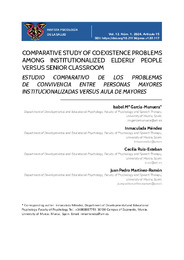Please use this identifier to cite or link to this item:
https://hdl.handle.net/11000/33935Full metadata record
| DC Field | Value | Language |
|---|---|---|
| dc.contributor.author | García Munera, Isabel | - |
| dc.contributor.author | MENDEZ, INMACULADA | - |
| dc.contributor.author | RUIZ-ESTEBAN, Cecilia | - |
| dc.contributor.author | Martínez Ramón, Juan Pedro | - |
| dc.contributor.other | Departamentos de la UMH::Psicología de la Salud | es_ES |
| dc.date.accessioned | 2024-11-19T13:39:49Z | - |
| dc.date.available | 2024-11-19T13:39:49Z | - |
| dc.date.created | 2024 | - |
| dc.identifier.citation | REVISTA PSICOLOGÍA DE LA SALUD Vol. 12. Núm. 1. 2024. | es_ES |
| dc.identifier.issn | 2386-2300 | - |
| dc.identifier.issn | 0214-6118 | - |
| dc.identifier.uri | https://hdl.handle.net/11000/33935 | - |
| dc.description.abstract | Theoretical Framework: Traditionally, bullying among peers has been confined to the school environ-ment; however, it is increasingly being shown that this phenomenon also occurs in other contexts. In this sense, several investigations have focused their attention on the phenomenon of bullying among older people. The aim of this study was to compare bullying problems among users belonging to ins-titutionalized centers with students in a classroom for the elderly. Method: Participants were N = 80 elderly people (M = 73.23 years; SD = 11.18) with 63.7% being female. A purposive sampling was carried out using a cross-sectional design. The Bullying Questionnaire adapted to Spanish was admi-nistered together with an ad hoc questionnaire to collect the sociodemographic characteristics in both groups. Results: The study has shown that bullying episodes also occur in older people, and are mainly verbal and relational harassment. Likewise, differences were found in the role of aggressor in bullying between the group belonging to institutionalized centers compared to the senior classroom. It was found that age was associated with the role of aggressor; however, no differences were found with respect to gender. Conclusions: The conclusions revolve around the need to create bullying prevention and intervention programs among the elderly in community settings to improve their quality of life and promote active aging. | es_ES |
| dc.description.abstract | Marco teórico: Tradicionalmente, el acoso entre iguales se ha circunscrito al ámbito escolar; sin embargo, cada vez está más demostrado que este fenómeno también se produce en otros contextos. En este sentido, diversas investigaciones han centrado su atención en el fenómeno del bullying entre personas mayores. El objetivo de este estudio fue comparar los problemas de bullying entre usuarios pertenecientes a centros institucionalizados con estudiantes de un aula de mayores. Método: Los par-ticipantes fueron N = 80 personas mayores (M = 73.23 años; DT = 11.18) siendo el 63.7% mujeres. Se llevó a cabo un muestreo de tipo intencional y un diseño transversal. Se administró el Cuestionario de Bullying adaptado al español junto con un cuestionario ad hoc para recoger las características socio-demográficas en ambos grupos. Resultados: El estudio ha puesto de manifiesto que los episodios de bullying también ocurren en personas mayores, siendo sobre todo acoso de tipo verbal y relacional. Del mismo modo se encontraron diferencias en el rol de agresor en bullying entre el grupo perteneciente a los centros institucionalizados en comparación con el aula de mayores. Se encontró que la edad se asociaba con el rol de agresor, sin embargo, no se encontraron diferencias con respecto al género. Conclusiones: Las conclusiones giran en torno a la necesidad de crear programas de prevención e in-tervención del bullying entre los mayores en entornos comunitarios para mejorar su calidad de vida y promover un envejecimiento activo. | es_ES |
| dc.format | application/pdf | es_ES |
| dc.format.extent | 12 | es_ES |
| dc.language.iso | eng | es_ES |
| dc.publisher | Universidad Miguel Hernández | es_ES |
| dc.rights | info:eu-repo/semantics/openAccess | es_ES |
| dc.rights.uri | http://creativecommons.org/licenses/by-nc-nd/4.0/ | * |
| dc.subject | bullying | es_ES |
| dc.subject | cyberbullying | es_ES |
| dc.subject | institutionalized center | es_ES |
| dc.subject | senior classroom | es_ES |
| dc.subject | aging | es_ES |
| dc.subject | acoso escolar | es_ES |
| dc.subject | ciberacoso | es_ES |
| dc.subject | centro institucionalizado | es_ES |
| dc.subject | aula de mayores | es_ES |
| dc.subject | envejecimiento | es_ES |
| dc.subject.other | CDU::1 - Filosofía y psicología::159.9 - Psicología | es_ES |
| dc.title | Comparative study of coexistence problems among institutionalized elderly people versus senior classroom | es_ES |
| dc.title.alternative | ESTUDIO COMPARATIVO DE LOS PROBLEMAS DE CONVIVENCIA ENTRE PERSONAS MAYORES INSTITUCIONALIZADAS VERSUS AULA DE MAYORES | es_ES |
| dc.type | info:eu-repo/semantics/article | es_ES |
| dc.relation.publisherversion | https://doi.org/10.21134/pssa.v12i1.117 | es_ES |

View/Open:
2125-.pdf
226 kB
Adobe PDF
Share:
.png)
